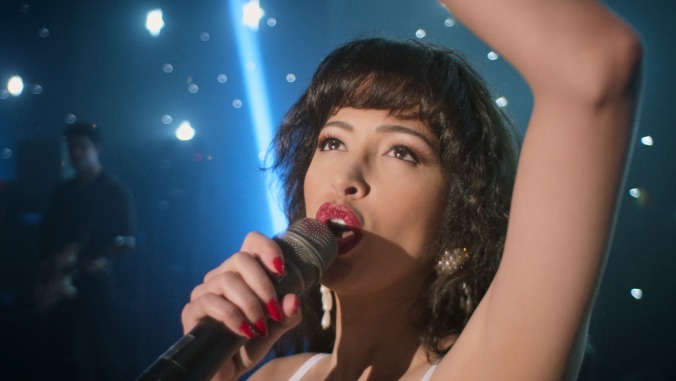The Walking Dead’s Christian Serratos steps into the famous botas de Selena; given the beloved reputation of the Selena film among fans, the actor has quite the road ahead of her in distinguishing her performance from Lopez’s portrayal. While it is apparent that Serratos made a significant effort to get the accent and cadence of the Mexican American Texas-born singer right, it’s hard not to hear an echo of Lopez’s take on the accent. Where Serratos shines is in the movements that were a signature of Selena’s. The singer-songwriter was not a trained dancer, which is why Lopez’s dance background didn’t quite work for the first biopic—Selena allowed herself to get lost in her dance breaks, which Serratos captures beautifully.
The series, sectioned in two parts (the first of which premieres December 4), tends to put a focus on the other Quintanilla siblings, Suzette (Noemi Gonzalez) and A.B. (Gabriel Chavarria), and how their father’s relentless quest for fame affected them as children and shaped them as adults. For those unfamiliar with the story of these two performers, this may come as a refreshing change of pace. But it’s Desperate Housewives alum Ricardo Chavira who really shines in the family ensemble as the imposing patriarch, Abraham Quintanilla (previously portrayed by Edward James Olmos). Chavira brings a quiet tenacity to the role that may make some viewers wonder if he’s someone to root for alongside Selena Y Los Dinos, or someone to resent.
Though the series offers a deeper exploration of the lives of Selena’s siblings, it still fails to take a new approach at retelling a retelling; much of the expository trajectory is identical to that of the film. What is presented in Part One feels rushed and crammed into nine episodes: Time jumps and flashbacks confuse not only the timeline but the viewer. It’s already quite a task to distill 23 years of life into what the creators considered to be “the most important moments,” but frontloading the first part of the series does the narrative a huge disservice. Selena: The Series also contains a breakdown in how other characters are introduced or portrayed and where they fall in the story. For example, Constance Marie played an outspoken version of Selena’s mother, Maricella Quintanilla, in the film; here Seidy López, who also starred in the Selena movie, offers a portrayal of Maricella that’s but a whisper in a stadium of 50,000. If her scenes were meant to bring levity to the series, juxtaposed next to the cheesy albeit comedic moments with the siblings, they don’t quite make a lasting impact. In turn, the other band members are so expeditiously introduced that viewers may have to double-back in order to be reintroduced.
Selena: The Series contains a sense of uncomfortable voyeurism, a feeling of déjà vu—things that have been seen and experienced before, but now there is an air of repeated intrusion. If the attempt was to dive into more of the lives of the other family members, a title change could have leveled expectations; those looking for Selena-driven stories will not encounter them until late in the first part of the run. Selena adored her fans; she opened her life up to them, but it’s hard not to wonder if she would be okay with multiple tellings of her story from one point of view—her family’s (Selena’s father and sister serve as executive producers alongside co-showrunners Moisés Zamora and Jaime Dávila). The 2018 Telemundo series, El Secreto De Selena, was publicly condemned by the family, who also took Selena’s husband Chris Pérez to court to stop his own series about her life from being brought to fruition.
While Selena’s cultural impact has been felt through the 25 years since her passing, from her signature red lip to the way she managed to make a white tee and jeans feel like the epitome of glamour, each familial telling of her story paints a saintlike picture. A different point-of-view would have given the series a nuanced story that would have set it apart from the film. Selena was and is greatly missed; that she broke down barriers for Latin women in the music industry is undeniable. Unfortunately, Selena: The Series follows in its predecessor’s footsteps too often to match the ground-breaking spirit of its subject.










































